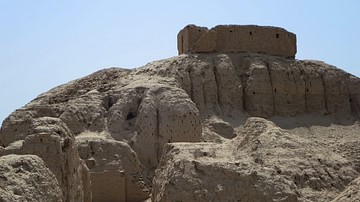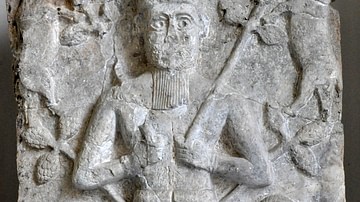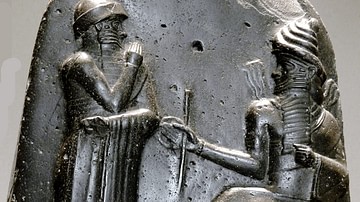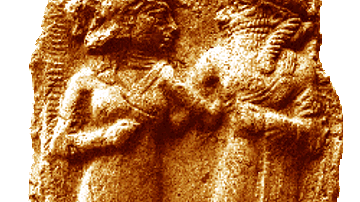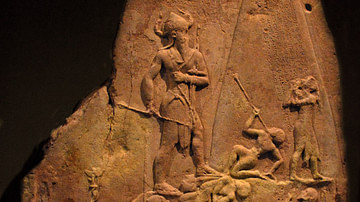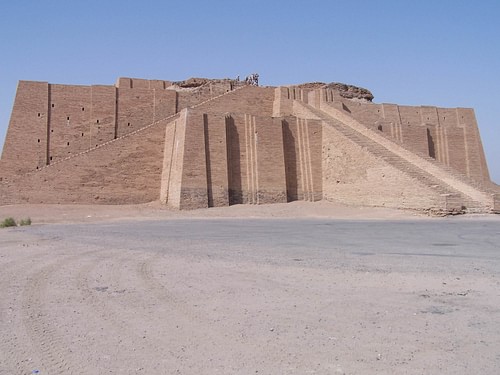
Nanna (also known as Nannar, Nanna-Suen, Sin, Asimbabbar, Namrasit, Inbu) is the Mesopotamian god of the moon and wisdom. He is one of the oldest gods in the Mesopotamian pantheon and is first mentioned at the very dawn of writing in Sumer c. 3500 BCE. His worship continued until the 3rd century CE.
Nanna was his Sumerian name while he was known as Sin, Nanna-Sin, Nanna-Suen and other names by the Akkadians, Assyrians, Babylonians, and others. His cult center was the great temple and ziggurat at the Sumerian city of Ur, and he is frequently mentioned in hymns and inscriptions from the Ur III Period (2047-1750 BCE) as the chief god of the pantheon with the epithet Enzu, lord of wisdom. His importance is evident in the number of inscriptions which refer to or praise him and the stories in which he features.
He was the son of Enlil and Ninlil and is their first-born after Enlil seduces Ninlil by the riverbank in the myth Enlil and Ninlil. His wife was Ningal (also Nikkal, the 'Great Lady'), a fertility goddess, and their children were Utu-Shamash (the sun god) and, in some stories, his twin sister Inanna/Ishtar (goddess of love and sexuality), Ereshkigal (Queen of the Dead), and Ishkur (also known as Adad, god of storms).
An interesting aspect of this family tree is that the moon (Nanna) is the father of the sun (Utu/Shamash). It is thought this belief originated in the early days of a hunter-gatherer social structure when the moon was more important to a community for traveling by night and telling the time of the month; the sun only became more important once the people settled down and began to practice agriculture. The religious belief, then, mirrored the cultural development. Scholar Stephen Bertman writes:
The Mesopotamians thus conceived of day, illuminated by the sun, as emanating from the darkness of night and the lesser light of the moon. As the time of lovemaking, the night and the moon were linked to the goddess of the erotic. As a source of light, the moon was also viewed as humanity's protector against acts of criminality undertaken under the cover of darkness even as the illuminating and all-seeing sun was looked upon as a guardian of justice. (122)
Nanna is represented as a recumbent moon and associated with the bull and lion-dragon. He is further depicted as a seated man with a long beard of lapis lazuli, a crescent moon above him, or riding on the back of a winged bull. In many inscriptions he is represented simply by the number 30, referring to the number of days in a lunar month, and the crescent moon was regarded as his barge in which he sailed through the night sky.
He was an immensely popular god, one of the original Sumerian pantheon. His cult center was at Ur and his most famous high priestess was Enheduanna (l. 2285-2250 BCE), although he also had an important temple at Harran in modern-day Syria where his son was Nusku, god of fire and light. Nanna, Ningal, and Nusku were worshiped as a triad, though this veneration mainly focused on the father and son.
Under the reign of Nabonidus (c. 556-539 BCE) the king's mother served as high priestess at Harran while his daughter held the same position at Nanna's temple in Ur. This arrangement consolidated Nabonidus' power in the same way that Sargon of Akkad (r. 2334-2279 BCE) had earlier placed his daughter Enheduanna in her position at Ur. Nanna is repeatedly seen in ancient texts as a god who provides and unifies, and some of the most successful Mesopotamian rulers capitalized on this belief.
Names & Significance
Nanna first appears under that name (whose meaning is unknown) c. 3500 BCE. He is already an important deity when he is mentioned as Sin/Suen during the reign of Sargon of Akkad and is referred to as "the illuminator." Even from this early period, he was associated with wisdom and was honored by Sargon's grandson, the great Naram-Sin (r. 2261-2224 BCE), who took his name upon coming to the throne. Naram-Sin, considered the greatest of the Akkadian kings, was among those who understood how to use religious belief to rule most effectively.
The Akkadians also knew Nanna/Sin by a number of other names, which are actually epithets such as Asimbabbar/Ashgirbabbar (possibly meaning 'embellisher' or 'he who embellishes'), Namrasit ('who shines forth'), and Inbu ('The Fruit,' possibly referring to the moon's changing shape). To the Babylonians, Nanna was the son of Marduk who created him and placed him in the sky.
Lunar eclipses were thought to be caused, in some eras, by gods or demons trying to steal the moon's light, and Nanna (or in some stories Marduk) had to fight against them to restore natural order. Bertman comments on how "during the new moon when Nanna/Sin's light was not visible, the god was said to be in the netherworld, where he judged the dead" (123). At one point or another throughout Mesopotamia's long history, Nanna was king of the gods, lord of wisdom, keeper of time, guardian of the future (diviner), holder of secrets, but is always seen as the devoted son of Enlil and a protector and guardian of humanity.
Nanna in Literature
Nanna/Sin is referred to at a number of points throughout The Epic of Gilgamesh where he is mentioned as the father of Shamash and Ishtar. Gilgamesh, at one point, even composes a song for Nanna, praising him for changes in life which inspire one to do great deeds. Nanna is similarly praised in other works and, in all, is closely associated with fertility and life.
His role as a keeper of time (guardian of the future) is especially interesting as he understands the past as the future. In looking at the past, Nanna was able to clearly see human destiny, collectively and individually, and those who came to him for divination could alter their future for the better by accepting his counsel. In addition to his wisdom and foresight, the god also offered many other gifts to humanity.
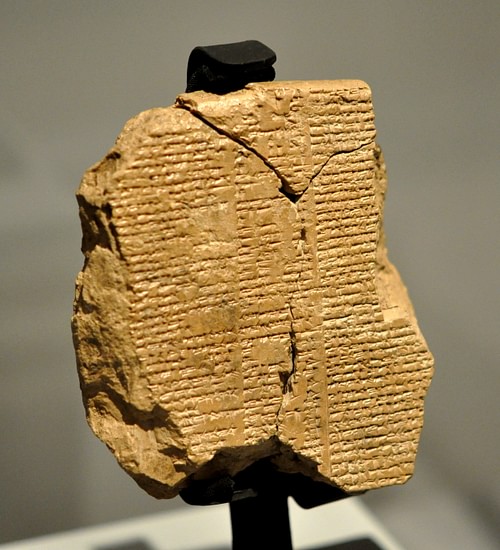
In the poem The Journey of Nanna to Nippur, the god is seen loading his boat at Ur with all good things to present to his father Enlil at the city of Nippur. Nanna fills his ship with trees, plants, and animals, and then makes his way upriver, stopping at five cities along the way where he is greeted and honors each one's god. Arriving at Nippur, he is greeted by Enlil's gatekeeper with joy and brought into his father's presence.
Nanna and Enlil feast together, and then Nanna makes a series of requests. He asks for the river to swell with sweet water, for the fields to yield abundant harvest, for success in cultivating honey and making wine, and for a long life to enjoy these gifts. Enlil grants his requests, and Nanna returns happily to Ur.
The poem is thought to represent the moon's association with fertility. Enlil was the King of the Gods, keeper of the Tablets of Destiny which foretold the fates of gods and mortals, and his decisions were final. His act of generosity in giving these gifts to Nanna meant that, through Nanna, they would be passed on to humanity and could not be revoked.
Nanna is depicted in a similar light in the poem The Herds of Nanna, in which he is praised as the "god of living creatures, leader of the land" and the great father of humanity. Although Enki was the creator god of the Sumerians, Nanna seems to have sometimes taken on this role as his worship spread across Mesopotamia. In the poem, he is again seen as the god who gives great gifts to humanity in abundance.
The work begins with the image of Nanna taking the night sky and illuminating it as the sun does at noon. He is the close confidant of his father Enlil, who "speaks with him day and night," and confers with him on the fate of human beings. Nanna's herds are then tallied and their number written on divine tablets by Nisaba, goddess of writing and scribe of the gods, and Nanna is then praised as the god of abundance who provides, among other gifts, alcoholic drink. Ninkasi was the goddess of beer, but this role is attributed to Nanna in the poem to emphasize his importance, as beer was the most popular drink in Mesopotamia.
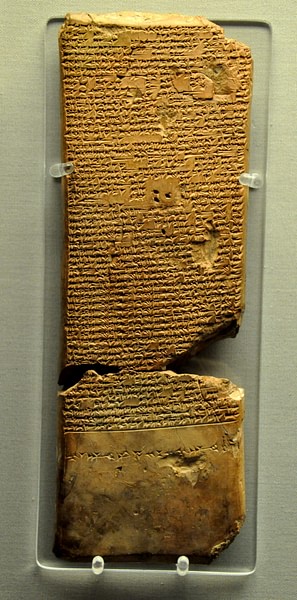
The god also appears in The Descent of Inanna, where he is listed as one of the deities Ninshubbur is to appeal to if Inanna does not return from the underworld, and in The Curse of Agade, the famous work of the Mesopotamian Naru Literature genre concerning Naram-Sin. In The Curse of Agade, after Naram-Sin has enraged Enlil through his ingratitude, Nanna is among the gods who try to act as mediators to spare humanity (and Naram-Sin specifically) from Enlil's wrath. His role as a protector and defender of humanity did not end with one's death, however, but continued on in the afterlife.
Nanna & Ningal
The Queen of the Dead in Mesopotamian mythology was Ereshkigal, older sister of Inanna, who ruled the underworld but, generally, passed no judgment on the dead. The dead, however great or modest their lives, all went to the same dark, dreary realm under the earth when their life was finished, and there they all shared the same fate as they ate dust and drank from puddles. This had been the standard belief among the people of Mesopotamia for millennia, but during the Ur III Period, Nanna was elevated to the role of judge of the dead. Scholar Samuel Noah Kramer writes:
The moon god Nanna decreed the fate of the dead. In the nether world...were to be found "bread-eating heroes" and "[beer] drinkers" who satisfy the thirst of the dead with fresh water. We learn, too, that the gods of the nether world can be called upon to utter prayers for the dead, that the personal god of the deceased and his city's god were invoked in his behalf, and that the welfare of the family of the deceased was by no means overlooked in the funerary prayers. (132)
This is quite a departure from the traditional view of the afterlife as "the land of no return" in which the dead were all made equal and lost their interest in the world of their former lives. Nanna became the bridge between the living and the dead through his judgment of their lives and intervention on the part of their families. Even so, as Kramer notes elsewhere, the Sumerians, for the most part, held to the belief that all were equal in the dreary world of the afterlife which was only a poor reflection of mortal existence.
Nanna's wife Ningal may also have had a part in the judgment of the dead, or at least as a prompt to good behavior, as a number of artifacts have been found which are known as "eyes of Ningal." These are crafted eye models usually cut from precious or semi-precious stone but also formed from clay. Sometimes these are only eyes and sometimes a figure in which the eyes are enlarged and accentuated with what appears a lemniscate, symbol for infinity (a sideways figure 8). It is unclear what the significance of these eyes was for the ancient Mesopotamians, but it is possible they reminded an owner that the eyes of the gods were on them.
Among the most interesting are a pair carved from onyx and dedicated by the king Nabonidus to Ningal. Even though eye carvings have been found associated with many other deities, these are unique, and those which seem to resemble them are also thought to have been dedicated to Ningal. The eyes could have been protective talismans or, as noted, reminders that the eyes of the Great Lady and her divine husband were always upon the living.
Many of these artifacts have been recovered from the ruins of Tell Brak (ancient Nagar) in modern-day Syria, not far to the east of Harran, and were most likely amuletic objects honoring Ningal or talismans reminding one of the protection - and eventual judgment - by Nanna. At Harran, Ningal's and Nanna's son Nusku was regularly invoked in the execution (by fire) of those convicted of practicing the dark arts after his parents had presided over the defendant's trial.
It is not surprising to find Nanna in a position of judgment since he is included in early Sumerian god lists as among the first who decree the fates of humanity. The earliest group consisted of the Seven Divine Powers: Anu, Enki, Enlil, Inanna, Nanna-Sin, Ninhursag, and Utu-Shamash. All seven of these would change and grow and assume different roles and responsibilities throughout Mesopotamian history, but Nanna remains more or less the same from his inception.
As with many Mesopotamian gods, Nanna was incorporated into the Assyrian pantheon and, when the Neo-Assyrian Empire fell in 612 BCE, a great number of these deities lost favor. Nanna continued to be recognized, however, and was still worshiped in the region of Syria as late as the 3rd century CE when he was replaced by the Christian God.
